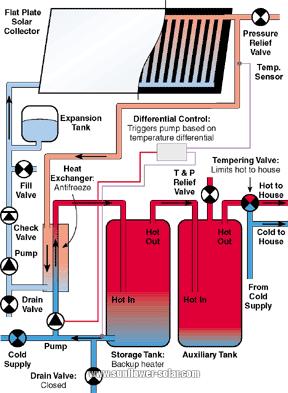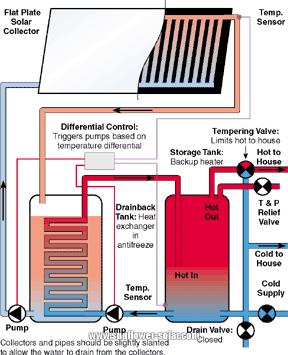Let us learn about solar system on you-differents system
Author:Ken Olson
From:None
Post time:04/11/2012
View:6788
In climates where freezing rarely occurs, a reduction of differential control the circulation pump turned on, if the collector inlet temperature to 40 ° F (4.4 ° C) turn. The philosophy behind this design is that the costs for heating low cost protection is your collectors with hot water from the tank, if only required occasionally.
These systems were often used in the sun belt, and only there, where freezing is a rare opportunity. Closed-circuit installations are no longer very often on the susceptibility to freezing as a result of power outages, failure of the sensor or controller or damaged sensor wires used.
Draindown System (Not Recommended)
A drain-down system is an open loop system in which the collectors with water under house pressure are filled, if it there is no risk of freezing. Once the system has been filled, a differential regulator working a pump water out of the tank by the collectors move.
A drain-down valve, invented in the 1970s only for these systems, offers frost protection function. If the collector current inlet temperature to 40 ° F (4.4 ° C) isolated the drain-down valve, the control inlet and outlet of the tank enables the collector. At the same time, it opens a valve that can drain off water in the collector. A vacuum breaker is installed always at the forefront of collectors, collectors at the top give the air so that water can drain out of the ground. Directly next to the vacuum circuit breakers, you find an automatic ventilation so that the air can escape if the system fills again.
Drain-down systems have the most problems of all protection systems. They are prone to frozen vacuum breaker and vents, sensors or lines, lack of suitable pipe damaged drainage and errors with the drain-down valve. This type of system is rarely new more installed and is not recommended. Many were Drainback or regulation converted antifreeze systems.
Closed Loop Antifreeze Heat Exchanger
Closed-loop antifreeze systems offer the most reliable protection against freezing. These systems circulate an antifreeze solution through the collectors and a heat exchanger. Propylene glycol is the most common antifreeze solution. In contrast to ethylene glycol (used in the automobile radiator), propylene glycol is non-toxic.
The closed-loop antifreeze systems have typically most. Here you will find a conservator, so that the antifreeze to expand and shrink with temperature change. Here you will find a pressure relief valve to high pressure in closed-loop to protect; a spring-loaded non-return valve to the closed control loop reflux at night to prevent, so collectors will not dissipate the heat from the water heater, an air-ventilation and / or air Eliminator to help to get the air out of the closed-loop system (air is your enemy, it can block fluid through the system) and a pressure gauge can tell you if your system is still loaded. A few temperature are a good idea in a system can tell you how good the system is.
There is also a mounting the fittings. Two boiler drains with a shut-off valve between allows you to recharge the system with your loading pump. As soon as ready, to recharge the closed loop with antifreeze solution, a charge pump will circulate used, the fluid in the loop, emissions of all air in the process.
Closed-loop systems like this are quite common, for the solar water heating, underfloor heating or hydraulic foot bar heating be. In spite of the many additional parts and accessories, they have a high degree of reliability, and are understood well by heating contractor.
Es ist ein Nachteil der Closed-Loop-Frostschutz-System-Design. Sobald eine solare Warmwasserbereitung System seine täglichen Aufgaben erfüllt hat, hält das System im Umlauf. Ohne Zirkulation um Wärme von den Kollektoren zu entfernen, können die Temperaturen so hoch wie 400 klettern ° F (204 ° C).
Diese hohen Stagnation Temperaturen, wie sie genannt werden, kann es zu Problemen mit Lufteinschlüssen und Abbau von Glykol-Frostschutzmittel-Lösungen. Lufteinschlüsse bilden, da hohe Temperaturen gelösten Gase aus der Lösung aus anzutreiben. Systeme mit Propylenglykol als Frostschutzmittel kann einen Inhibitor zu verwenden, um die Lebensdauer Additiv des Glykols zu verlängern. Andernfalls kann das Glykol brechen, was zu einer schlammigen Ablagerung. Silicium und Kohlenwasserstoffölen verwendet worden, um diese Probleme zu vermeiden, aber sie sind teuer und sind nicht mit Dichtungen in den meisten off-the-shelf Komponenten vorhanden.
Drainback: A Simpler Closed Loop
Although similar in name the drain-down type system is the Drainback system quite different and still much more reliable. It offers some advantages over the closed loop tempering. Systems can use drain back water as heat transfer fluids, because collectors empty when it is not in operation. Frost provides an added level of protection from poor drainage and controller or sensor errors.
A pump with a differential control is operated, when the collector outlet at least 20 ° F (11 ° C) warmer than the tank outlet shot. Water or an antifreeze solution is raised from a small storage tank and circulates through the collectors and back to the tank. Heat to the water through a heat exchanger transferred to the storage tank. The circulation loop through the collectors is a closed loop. The water or antifreeze solution is installed at the time of installation and provides no recurring supply of oxygen.
A Drainback system requires a larger pump than any of the other systems described here. There must be sufficient capacity to lift the liquid to the highest point of the system. If no heat is collected, control the pump turns off, and the whole liquid flows back into the reservoir. The collectors are empty. They can not freeze, and they can not overheat antifreeze. As a DIY homeowner need not a special charge pump either. If, at the time to change the antifreeze, you can simply empty and fill you the container lids.